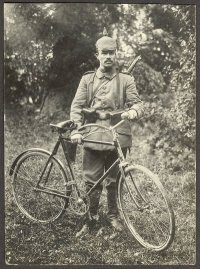With
bicycles so popular in the late 19th century, in Europe, the United States and
Australia, it was inevitable the military would find a use for them. Bicycles
were easier to care for than horses, required no fuel or food, a small storage
space and little maintenance. They were quiet, and riders could be easily
trained. Soldiers previously on foot could travel faster and carry more with a
cycle. Bicycle units were formed at the end of the 19th century by all European armies
and the US armed forces, and to some extent took over from the mounted
infantry.
 |
| Cycle company at Bury St Edmonds, Suffolk |
Folding
bicycles were developed from about 1895 by Morel and Geraud, and the French
army tested about 25 of these bikes. The patent for the folding bike was sold to a
consortium of Peugeot, Michelin, and the French army and they took over
production of the bike in 1899.
In 1896 in the United
States, an extensive experimentation on bicycle units was carried out by a 1st
Lieutenant Moss, of the Twenty-fifth United States Infantry Regiment (one of
the racially segregated units of the United States Army known as Buffalo
Soldiers). The 25th Infantry U.S. Army Bicycle Corps set out across the country
on bicycles from Fort Missoula, Montana to several different locations with their
greatest trip covering 1,900 miles to St. Louis, Missouri, returning to
Missoula by train. Here they are at Minerva Terrace, Yellowstone National
Park, 1897.
 |
| Photos by Frank Jay Haynes Source |
 |
| Soldier during the 2nd Boer War source |
 |
| Soldiers with early folding cycles |
Three years later in the Second
Boer War, military cyclists were used primarily as scouts and
messengers, although several raids were conducted by cycle-mounted infantry on
both sides.
 |
| Simon Dussault folding bicycle c. 1895 |
One unit patrolled railroad
lines on specially constructed tandem bicycles that were fixed to the
rails. Mikael Pedersen had developed a two-rider tandem version of his Pedersen bicycle in about 1898 that weighed 24 pounds, and a four-rider, or
"quad", that weighed 64 pounds, and earlier in 1895 Julien Simon and Victor Dussault, both of
Paris, France, patented a folding tandem
bicycle which they described a regular folding bike that could be converted
into a folding tandem with the addition of another frame and connecting parts.
Other early folding bikes were the Faun Folding Cycle
produced in England in 1896 and the Dwyer Folding Bicycle made in Connecticut ,
designed by Michael B. Ryan, which was sold to the military as well as the
public. This photo is from an article
about the Dwyer folding bicycle in the Scientific American magazine dated March
13, 1897 showing a soldier demonstrating the folding operation of the bike.
The uniforms for cyclist soldiers tended to have loose pants and gaiters, no matter which army they were fighting for. Very similar to this Sardinian uniform from 1859, which I had to include because I just love it!
Deb xx




I am really loving your bicycle articles! I never even stopped to think about the history of a bicycle, let alone the fashions in history. Another great post.
ReplyDeletethank you. I can remember a photo of my grandfather in WWII uniform with a bicycle, so I am trying to locate it and will post it soon too.
ReplyDelete